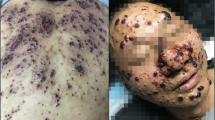Abstract
Only nine cases of AIDS-related cryptococcosis have been reported until now in patients receiving highly active antiretroviral therapy (HAART),all of them with abnormal clinical features. Two HIV-infected patients who experienced an atypical relapse of cryptococcosis shortly after the start of HAART and despite maintenance antifungal treatment, are described. Six different relapses of cryptococcal meningitis were observed in a 28-month period in a patient who obtained a poor immune recovery after HAART (as shown by a CD4+ lymphocyte count ranging from 78 to 149 cellsμL, opposed to a baseline level of 98 cellsμL). On the other hand, a patient with favorable immunological response to HAART(as expressed by a CD4+ count growing from 7 to 186 cellsμL),experienced isolated multiple indolent cryptococcal abscesses involving head,neck, the anterior thoracic wall, and regional lymph nodes, with repeatedly negative cultures, and diagnosis obtained by both histopathologic study and positive serum antigen assay. Both our case reports are representative of novel correlations between opportunistic pathogens and immune reactivity, descending from the introduction of HAART. The first episode describes an exceedingly elevated number of disease relapses despite HAART and antifungal maintenance treatment, which may descend from an incomplete immune response to antiretroviral therapy, possibly responsible for failure in obtaining eradication of yeasts, but also for lack of disease dissemination (usually leading to a lethal multivisceral involvement in the pre-HAART era). The abnormal disease course and localization of second reported patient well depicts an “immune reconstitution syndrome” probably representing a flare-up of a latent fungal infection, caused by a rapidly effective HAART. In patients treated with HAART, AIDS-related cryptococcosis cannot therefore be ruled out by the absence of neurological involvement, and by persistingly negative cultures.
Similar content being viewed by others
References
Rozenbaum R, Gonçalves AJR. Clinical epidemiological study of 171 cases of cryptococcosis. Clin Infect 1994; 18: 369–380.
Oursler KA, Moore RD, Chaisson RE. Risk factors for cryptococcal meningitis in HIV-infected patients. AIDS Res Hum Retroviruses 1999; 15: 625–631.
Hajjeh RA, Conn LA, Stephens DS et al. Cryptococcosis: population-based multistate active surveillance and risk factors in human immunodeficiency virus-infected persons. J Infect Dis 1999; 179: 449–454.
Woods ML II, MacGinley R, Eisen DP, Allworth AM. HIV combination therapy: partial immune restitution unmasking latent cryptococcal infection. AIDS 1998; 12: 1491–1494.
Blanche P, Gombert B, Ginsburg C et al. HIV combination therapy: immune restitution causing cryptococcal lymphadenitis dramatically improved by anti-inflammatory therapy. Scand J Infect Dis 98; 30: 615–616.
Michelet C, Arvieux C, François C et al. Opportunistic infections occurring during highly active antiretroviral treatment. AIDS 1998; 12:1815–1822.
Lanzafame A, Trevenzoli M, Carretta G, Lazzarini L, Vento S, Concia E. Mediastinal lymphadenitis due to cryptococcal infection in HIV-positive patients on highly active antiretroviral therapy. Chest 1999; 16: 848–849.
Holtzer CD, Jacobson MA, Hadley WK et al. Decline in the rate of specific opportunistic infections at San Francisco General Hospital, 1994-1997. AIDS 1998; 12: 1931–1933.
Li TS, Tubiana R, Katlama C, Calvez V, Mohand HA, Autran B. Long-lasting recovery in CD4 T-cell function and viral-load reduction after highly active antiretroviral therapy in advanced HIV-1 disease. Lancet 1998; 351: 1682–1686.
Lundgren J, Masur H. New approaches to managing opportunistic infections. AIDS 1999; 13 (Suppl.): S227–S234.
Kirk O, Lundgren JD, Pedersen C, Nielsen H, Gerstoft J. Can chemoprophylaxis against opportunistic infections be discontinued after an increase in CD4 cells induced by highly active antiretroviral therapy? AIDS 1999; 13: 1647–1651.
Powderly WG, Landay A, Lederman MM. Recovery of the immune system with antiretroviral therapy. The end of opportunism? JAMA 1998; 280: 72–77.
Palella FJ, Delaney KM, Moorman AC et al. Declining morbidity and mortality among patients with advanced human immunodeficiency virus infection. N Engl J Med 1998; 338: 853–860.
Forrest DM, Seminari E, Hogg RS et al. The incidence and spectrum of AIDS-defining illnesses in persons treated with antiretroviral drugs. Clin Infect Dis 1998; 27: 1379–1385.
Chêne O, Binquet C, Moreau JF et al. Changes in CD4C cell count and the risk of opportunistic infection or death after highly active antiretroviral treatment. AIDS 1998; 12: 2313–2320.
Mocroft A, Sabin CA, Youle M et al. Changes in AIDSdefining illnesses in a London Clinic, 1987-1998. J Acquir Immune Defic Syndr Hum Retrovirol 1999; 21: 401–407.
Pakker NG, Notermans DW, De Boer RJ et al. Biphasic kinetics of peripheral blood T cells after triple combination therapy in HIV-1 infection: a composite of redistribution and proliferation. Nature Med 8; 4: 208–214.
Autran B, Carcelaint G, Li TS et al. Restoration of the immune system with anti-retroviral therapy. Immunol Lett 1999; 66: 207–211.
Pakker NG, Kroon ED, Roos MT et al. Immune restoration does not invariably occur following long-term HIV-1 suppression during antiretroviral therapy. INCAS Study Group. AIDS 1999; 13: 203–212.
Jacobson MA, Zegans M, Pavan PR et al. Cytomegalovirus retinitis after initiation of highly active antiretroviral therapy. Lancet 1997; 349: 1443–1445.
Race EM, Adelson-Mitty J, Knegel OR et al. Focal mycobacterial lymphadenitis following the initiation of protease inhibitor therapy in patients with advanced HIV-1 disease. Lancet 1998; 351: 252–255.
Karavellas MP, Plummer DJ, MacDonald JT et al. Incidence of immune recovery vitritis in cytomegalovirus retinitis patients following institution of successful highly active antiretroviral therapy. J Infect Dis 1999; 179: 697–700.
Buchanan KL, Murphy JW. Regulation of cytokine production during the expression phase of the anticryptococcal delayedtype hypersensitivity response. Infect Immun 1994; 62: 2930–2939.
Retini C, Vecchiarelli A, Monari C et al. Capsular polysaccharide of Cryptococcus neoformans induces proinflammatory cytokine release by human neutrophils. Infect Immun 1996; 64: 2897–2903.
Author information
Authors and Affiliations
Rights and permissions
About this article
Cite this article
Manfredi, R., Pieri, F., Pileri, S.A. et al. The changing face of AIDS-related opportunism: Cryptococcosis in the highly active antiretroviral therapy (HAART) era. Case reports and literature review. Mycopathologia 148, 73–78 (2000). https://doi.org/10.1023/A:1007156027134
Issue Date:
DOI: https://doi.org/10.1023/A:1007156027134




